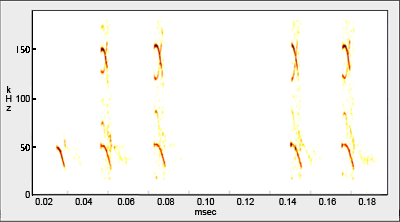Additional:
We occasionally detect this species acoustically at the headwaters of the Martha Brae, notably at the "Big Bridge", and Matthew Emrich caught one once in a mist net at the bridge (13-July-2011). Although it is
included in the bat species checklist for Windsor Great Cave in Alan Fincham's Jamaica Underground (1997), we believe this is a mistake -- we've never detected Noctilio inside or
exiting the cave and suspect that any specimens caught near the river actually roost downstream in coastal sea-caves. A radio-telemetry study would be invaluable for learning about their movements.
In Cuba, gestation occurs from December to April, with pregnant females in April containing a near-term fetus (Silva Taboada 1979). Pregnant females were not found in May or June, but a few with very small embryos have been found in July and August. On the Puerto Rican island of Culebra, copulation occurs from September to November, but young are not observed until May: this 9-month interval between mating and parturition indicates some type of reproductive delay, such as delayed fertilization or delayed implantation (Brooke 1997).
Males and females both produce an oily yellow fluid that accumulates on the skin and fur under the wings (Brooke and Decker 1996). To quote further, "the secretions are quite odiferous, and it is possible for some humans to identify a bulldog bat on the basis of odor alone as it flies in the dark." Matthew and WRC's Susan Koenig certainly noticed the fishy stench of the adult female Noctilio they examined in 2011. They also were amused to hear her audible sound, which she produced while inside a cotton holding bag. It was rather like a cross between an cicada-like buzz and a purring kitten. So, Bat Man is really Cat Woman?
This is a "clearly, more research is needed" species on Jamaica.
Acknowledgements:
We captured the adult female during field research supported by:
 |
Literature Reviewed
Brooke, A.P. 1994. Diet of the fishing bat, Noctilio leporinus (Chiroptera: Noctilionidae). Journal of Mammology 75:212-218.
Brooke, A.P. and D.M. Decker. 1996. Lipid compounds in secretions of the fish-eating bat Noctilio leporinus (Chiroptera: Noctilionidae). Journal of Chemical Ecology 22:1411-28.
Brooke, A.P. 1997. Social organization and foraging behaviour of the fishing bat, Noctilio leporinus (Chiroptera: Noctilionidae). Ethology 103:421-36.
Fincham, A. 1997. Jamaica Underground. Unversity of the West Indies Press, Mona, Jamaica. pp. 447.
Gannon, M.R., A. Kurta, A. Rodriguez-Duran, and M.R. Willig. 2005. Bats of Puerto Rico. University of the West Indies Press, Mona, Jamaica. pp. 239.
Nowak, R. M. 1994. Walker's bats of the World. Johns Hopkins University Press, Baltimore, MD. pp. 288.
Schnitzler, H.-U., E. Kalko, I. Kaipf, and A.D. Grinnell. 1994. Fishing and echolocation behavior of the greater bulldog bat, Noctilio leporinus, in the field Behavioral Ecology and Sociobiology 35:327-45.
Silva Taboada, G. 1979. Los murciélogos de Cuba. Habana. Editorial de la Academia de Ciencias de Cuba. pp. 425.






